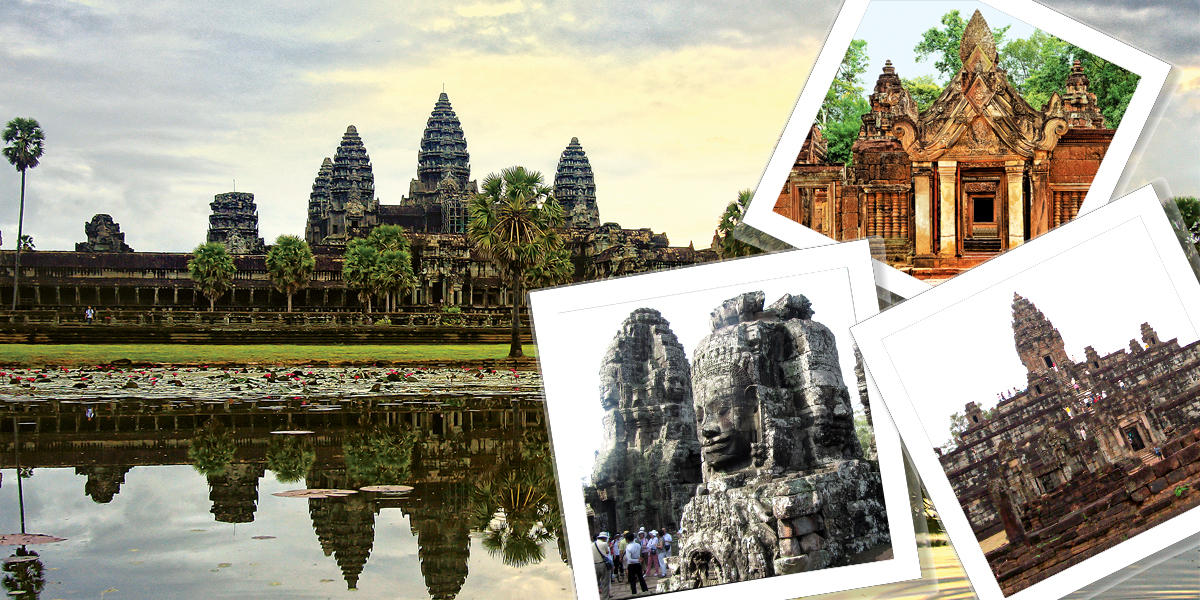UNESCO The Angkor Archaeological Park
The Angkor Archaeological Park in the province of Siem Reap located in the northern part of Cambodia, is recognised to be one of the most important archaeological sites in South-East Asia. Stretching over some 400 km2, including forested area, the Angkor Archaeological Park contains the magnificent remains of the different capitals of the Khmer Empire, from the 9th to the 15th century. They include the famous Temple of Angkor Wat and the great city of Angkor Thom where the awe-inspiring Bayon Temple with its multiple towers of smiling faces, the Elephant Terrace, the Preah Khan temple and the jungle temple of Ta Prohm are situated. Beside these, there are scores of other temples in the park as well.
For several centuries, Angkor was the centre of the Khmer Kingdom.
With impressive monuments, a multitude of ancient urban plans, large reservoirs, basins, dykes, canals and communication routes, the site is an unique concentration of features testifying to an exceptional civilization.
Temples such as Angkor Wat, the Bayon, Preah Khan and Ta Prohm, exemplars of Khmer architecture, are closely linked to their geographical context as well as being imbued with symbolic significance.
The foremost Hindu concept of the mountain-temple, upon which temples like the Angkor Wat and several others are built, symbolises the mythical Mount Meru where the gods reside
The temples, including Angkor Wat, are typically surrounded by moats and built in a mountain-like form topped precisely by five towers, representing the five peaks of Mount Meru.
With preservation and protection efforts, Angkor is as inspiring today as it must have been when it was a thriving city; a highly recommended destination to visit.
ANGKOR WAT HERITAGE OF HUMANITY AND WORLD WONDER
Angkor Wat, one of the greatest cultural wonders of the world, is the most ancient and largest religious monument on the planet. It is probably also the only monument in the world that is decorated with carvings, minute or large, on just about every surface of the entire complex.
Unlike most Angkorian temples which are commonly directed to the east, Angkor Wat is oriented to the west, a direction that got many archaeologists and scholars wondering whether it was indeed the intention of King Suryavarman II to use it as a funerary temple or was it designed to align with the sun; to connect the earth with the sky. The sun raises exactly on the peak of the main Angkor Temple twice a year during the equinox and as the sun sets, the entire temple facade evolved to a radiant gold; phenomenal.
Angkor Wat which literally means ‘Temple of Angkor’, is a complex built to replicate the heavens on earth. Constructed for king Suryavarman II in the early twelfth century, it is the best-preserved temple and is the only one to have remained a significant religious centre since its foundation; first Hindu, dedicated to Vishnu, then Buddhist. The temple is the epitome of the high classical style of Khmer architecture. This magnificent temple combines two basic plans of Khmer temple architecture; the temple mountain and the later galleried temple, based on early South Indian Hindu architecture.
Constructed within a moat and an outer wall 3.6 kilometres (2.2 miles) long with three rectangular galleries, each raised above the next, it is designed to represent Mount Meru, home of the devas in Hindu mythology. At the centre of the temple stands a quincunx of towers corresponding to the peaks of Meru.
This is a meticulously planned religious complex as can be seen from details given to the designs and architecture; all the window bars are designed such that under the glare of the sun, silhouettes of Mount Meru are displayed all over the surrounding surfaces; a feat cleverly achieved by the religious Khmer architects.
Angkor Wat is the largest religious monument on the planet and probably the only one in the world that is decorated with carvings, minute or large, on just about every surface of the entire complex.
The temple is admired for the grandeur and harmony of the architecture. The extensive bas-reliefs and the numerous guardian spirits adorning its walls serve as evidence of the strong Khmer religious beliefs.




